
RENAISSANCE QUARTERLY
Scope & Guideline
Connecting Scholars through Renaissance Discourse
Introduction
Aims and Scopes
- Interdisciplinary Research:
The journal emphasizes interdisciplinary scholarship, integrating perspectives from history, literature, philosophy, art history, and cultural studies to provide comprehensive insights into Renaissance culture. - Cultural Exchange and Global Perspectives:
RENAISSANCE QUARTERLY explores the dynamics of cultural exchange during the Renaissance, including interactions between Europe and non-European cultures, as well as the impact of colonialism and globalization. - Material Culture and Artistic Practices:
The journal frequently investigates material culture, focusing on the production, consumption, and significance of art objects, artifacts, and everyday life in Renaissance society. - Gender and Identity Studies:
A significant area of inquiry involves examining issues of gender, sexuality, and identity within Renaissance literature and culture, reflecting contemporary debates in gender studies. - Religious and Philosophical Contexts:
The journal addresses the complex interplay of religion, philosophy, and politics in the Renaissance, considering how these factors shaped individual and collective identities.
Trending and Emerging
- Environmental Humanities:
A growing interest in the environmental context of the Renaissance is emerging, with scholars examining how ecological concerns and the natural world influenced cultural and artistic production. - Digital Humanities and New Media:
The integration of digital tools and methods in Renaissance studies is on the rise, facilitating new forms of analysis, interpretation, and dissemination of research. - Transnational and Postcolonial Studies:
There is an increasing focus on transnational perspectives that analyze the Renaissance as a global phenomenon, considering the implications of colonialism and cultural exchange. - Emotional and Affective Histories:
Scholars are increasingly investigating the emotional dimensions of Renaissance literature and culture, exploring how feelings and affect shaped human experiences and identities. - Health and Medicine in the Renaissance:
Research on health, medicine, and the body during the Renaissance is becoming more prominent, reflecting contemporary concerns about bodily autonomy, health practices, and medical knowledge.
Declining or Waning
- Traditional Historical Narratives:
There has been a shift away from conventional historical narratives that focus solely on political events or prominent figures, as scholars increasingly seek to explore marginalized voices and alternative histories. - Exclusive Focus on European Perspectives:
The journal's previous emphasis on European-centric studies has diminished, giving way to more inclusive approaches that consider global interactions and the impacts of colonialism. - Static Interpretations of Art:
Analyses that rely heavily on established interpretations of art and literature without considering contemporary theoretical frameworks are appearing less frequently, as scholars adopt more dynamic and varied methodologies. - Narrow Gender Studies:
Earlier explorations that solely categorized gender roles within rigid frameworks are declining, with a growing preference for nuanced discussions that incorporate intersectionality and fluidity in identity.
Similar Journals
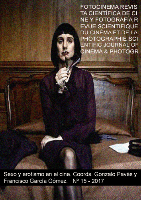
Fotocinema-Revista Cientifica de Cine y Fotografia
Exploring the Intersection of Visual Arts and SocietyFotocinema-Revista Cientifica de Cine y Fotografia is a leading open-access journal published by FOTOCINEMA since 2014, dedicated to the academic exploration of cinema and photography. Based in Spain, this journal serves as a vital platform for researchers, professionals, and students, fostering innovative discourse in the fields of Visual Arts, Performing Arts, and History. With an impressive Q2 rank in both History and Visual Arts, as well as a Q4 rank in Communication in 2023, Fotocinema reflects a commitment to high-quality scholarship, backed by Scopus rankings that highlight its growing influence within the academic community. By offering open access to its content, the journal ensures that significant research is available to a broader audience, encouraging collaboration and knowledge sharing across disciplines. As it continues its converged publication run from 2019 to 2024, Fotocinema stands at the forefront of cinematic and photographic studies, providing an essential resource for those dedicated to understanding the intricate relationships between visual media and society.

Religion and the Arts
Exploring the Sacred Intersection of Faith and CreativityReligion and the Arts is a distinguished scholarly journal published by BRILL, based in the Netherlands, with a dedicated focus on the interdisciplinary exploration of religion and its interplay with various artistic expressions from historical and contemporary perspectives. Established in 1996, this journal serves as a vital platform for researchers, professionals, and students interested in Cultural Studies, History, Religious Studies, and the Visual and Performing Arts. Despite its current classification in the Q4 category across multiple fields, it remains committed to advancing academic discourse and fostering innovative approaches to understanding the complex relationships between spirituality and artistic creation. With its ISSN 1079-9265 and E-ISSN 1568-5292, the journal invites submissions that contribute to enriching this dynamic field, ensuring that a diverse range of voices and perspectives are represented. Although not an Open Access publication, the journal’s content continues to be pivotal for scholarly engagement and is essential reading for those dedicated to the study of art's profound connections with religious traditions.
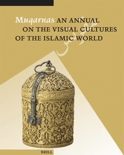
Muqarnas-An Annual on the Visual Cultures of the Islamic World
Exploring the Rich Tapestry of Islamic Visual CultureMuqarnas: An Annual on the Visual Cultures of the Islamic World, published by BRILL, stands as a seminal contribution to the academic discourse surrounding the visual cultures intrinsic to Islamic societies. With its ISSN 0732-2992 and E-ISSN 2211-8993, this prestigious journal, based in the Netherlands, has been a vital resource for scholars since its inception in 1985. Specializing in the intersection of Cultural Studies, History, and Visual Arts, Muqarnas is recognized as a Q1 journal in Visual Arts and Performing Arts and maintains strong positions in other academic categories, underscored by impressive Scopus rankings. Offering a deep exploration of visual traditions and practices, the journal fosters a broader understanding of Islamic art and architecture's historical contexts, contributing significantly to its field. With its rigorous peer-review process and commitment to scholarly excellence, Muqarnas invites researchers, professionals, and students to engage with the rich tapestry of Islamic visual culture, ensuring its relevance and importance for contemporary scholarship.

ARCHIVO ESPANOL DE ARTE
Exploring the Depths of Artistic ExpressionARCHIVO ESPANOL DE ARTE is a distinguished journal dedicated to the exploration and dissemination of research in the fields of visual arts and performing arts. Published by CONSEJO SUPERIOR INVESTIGACIONES CIENTIFICAS-CSIC in Spain, this journal has been an open access publication since 1996, facilitating unrestricted access to valuable scholarly content for researchers, professionals, and students alike. With an E-ISSN of 1988-8511 and a commitment to covering a range of artistic phenomena, it plays a significant role in advancing the understanding and appreciation of art within both academic and cultural contexts. Although currently categorized in the Q4 quartile within its discipline, its ranking within Scopus—at #400/667, placing it in the 40th percentile—reflects its contributions to the broader discourse in art research. The journal's suite of open access offerings ensures that cutting-edge research remains accessible, fostering collaboration and innovation in the ever-evolving landscape of the arts.
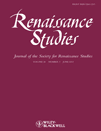
Renaissance Studies
Fostering Interdisciplinary Insights into the RenaissanceRenaissance Studies, published by Wiley, stands as a vital academic platform within the disciplines of Cultural Studies, History, Literature and Literary Theory, Religious Studies, and Visual Arts and Performing Arts. With an impressive history of publication spanning from 1987 to 2024, this journal is recognized in 2023 metrics as a Q2 journal in four categories and Q1 in Literature and Literary Theory, reflecting its substantial impact in promoting interdisciplinary dialogue and research. The journal's robust Scopus rankings further underscore its relevance, including a position in the 83rd percentile in Literature and Literary Theory. Although not an open-access journal, it provides readers and contributors with access to curated, high-quality scholarship that explores the complexities of the Renaissance and its enduring influence on contemporary thought and culture. Researchers, professionals, and students alike will find Renaissance Studies invaluable in fostering discussions that bridge historical context with modern inquiry.

Umeni-Art
Elevating Artistic Discourse through Rigorous ResearchUmeni-Art is a prominent journal in the field of visual arts and performing arts, published by the Institute of Art History, Academy of Sciences, Czech Republic. With its ISSN 0049-5123 and E-ISSN 1804-6509, the journal has established itself as a critical platform for scholarly discourse and artistic expression since its inception in 2002. Although currently classified in Q4 within the Arts and Humanities category, it aims to elevate the understanding and appreciation of the arts through rigorous research and innovative perspectives. The journal's Scopus ranking places it at Rank #573/667, reflecting its growing contribution to the field and expanding reach within the artistic community. With a focus on fostering collaboration among researchers, practitioners, and students, Umeni-Art seeks to enrich the academic landscape with significant findings and discussions that inspire future research and creative endeavors. While it does not offer open access, the journal remains a valuable resource for those vested in exploring the dynamic interplay between art, culture, and society in the contemporary context.
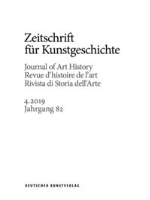
ZEITSCHRIFT FUR KUNSTGESCHICHTE
Fostering Insightful Discussions on Art and CultureZEITSCHRIFT FUR KUNSTGESCHICHTE is a prestigious journal dedicated to the study of art history, offering insightful analyses and discussions that enrich the understanding of visual arts and performing arts. Published by DEUTSCHER KUNSTVERLAG GMBH in Germany, this journal has established itself as a significant platform for researchers and professionals alike since its inception. With a print ISSN of 0044-2992 and an e-ISSN of 2569-1619, it spans a comprehensive range of topics in art history, reflecting both traditional and contemporary perspectives. Although categorized in the Q4 quartile for Visual Arts and Performing Arts, the journal contributes to a rich dialogue within its field, aiming to foster academic discourse and promote scholarly research. Its scope has evolved notably from converged years starting in 1975 and gathering strength from 2001 to 2024, and it is committed to serving as an essential resource for students, academics, and practitioners in the arts. While not offering open access, the journal maintains a rigorous peer-review process to ensure high-quality submissions that advance knowledge and stimulate critical thought.
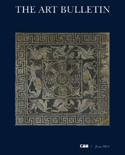
ART BULLETIN
Fostering Innovative Perspectives on Artistic ExpressionART BULLETIN is a prestigious journal dedicated to the fields of history and visual arts, published by Routledge Journals, Taylor & Francis Ltd. With a rich publication history dating back to 1945, this journal serves as a vital platform for scholarly discourse, presenting cutting-edge research and critical analyses that contribute to our understanding of the arts across various contexts. Despite its Q3 ranking in both the History and Visual Arts categories, the journal has managed to achieve notable stature among its peers, evidenced by its Scopus ranking, placing it in the top 20% for Visual Arts and in the top 25% for History. Scholars and students alike will find valuable insights and innovative perspectives within its pages, making it an essential resource for anyone invested in the academic exploration of art and cultural history. Although currently not open access, the journal is committed to fostering an informed community by disseminating works that encourage scholarly engagement and creative thought.

RICERCHE DI STORIA DELL ARTE
Unveiling Artistic Narratives Through TimeRICERCHE DI STORIA DELL ARTE is a prominent academic journal published by NUOVA ITALIA SCIENTIFICA SPA, dedicated to the exploration and analysis of art history. With an ISSN of 0392-7202, the journal has been a significant platform for researchers and scholars since its inception, converging its content through the years from 2009 to 2024. Situated in Italy, it focuses on the visual arts and performing arts domains, holding a Q4 quartile ranking in the 2023 category. Although it operates under a traditional subscription model, it curates a variety of studies and papers that contribute valuable insights into the historical context and development of art. This publication is particularly essential for academics, professionals, and students seeking to deepen their understanding of art history and its relevance in contemporary discussions.

Artibus et Historiae
Navigating the Rich Tapestry of Artistic HeritageArtibus et Historiae is a distinguished academic journal published by IRSA PUBLISHING HOUSE, focusing on the fields of Visual Arts and Performing Arts within the broader scope of Arts and Humanities. With an ISSN of 0391-9064, this journal has become a crucial platform for the dissemination of scholarly research, critical discourse, and innovative ideas in art history and visual culture. Though its coverage in Scopus was discontinued in 2018, it maintained a respectable ranking of #279 out of 502 in its category, placing it in the 44th percentile. This positions Artibus et Historiae as a respected contributor to scholarly conversations in its field. Researchers, professionals, and students will find valuable insights and analyses that deepen their understanding of artistic practices and historical contexts. While not an open-access journal, it aims to bridge the gap between academia and broader audiences interested in the dynamic interplay of art and history.